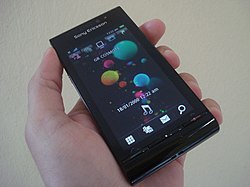 | |
 Sony Ericsson Satio | |
| Developer | Sony Ericsson |
|---|---|
| Manufacturer | Sony Ericsson |
| Type | Camera phone |
| Series | S-series |
| Availability by region | 7 October 2009 (UK), Late 2009 (USA) |
| Predecessor | Sony Ericsson C905 |
| Successor | Sony Ericsson Vivaz |
| Compatible networks | GSM GPRS/EDGE 850/900/1800/1900, UMTS HSDPA 900/2100 (Satio), GSM GPRS/EDGE 850/900/1800/1900 UMTS HSPA 850/1900/2100 (Satio(a)) |
| Form factor | Touchscreen |
| Dimensions | 112 x 55 x 13 mm |
| Weight | 126 grams |
| Operating system | Symbian OS 9.4 running S60 5th edition |
| Memory | 256 MB RAM and 128 MB ROM (Internal storage) |
| Storage | 128 MB |
| Removable storage | microSDHC up to 32 GB, 8 GB included |
| SIM | miniSIM |
| Battery | Li-Po 1000 mAh |
| Charging | Fast port (proprietary) up to 5W (standard charging speed) |
| Rear camera | 12.1 MP, 4000 x 3000 pixels, auto-focus, xenon flash, video LED flash |
| Front camera | 0.3 Megapixel (VGA) |
| Display | TFT touchscreen, 16M colours 3.5 in (89 mm), 360 x 640 pixels |
| Connectivity | Wi-Fi (802.11 b/g, DLNA), A-GPS, Bluetooth (v2.0 with A2DP) |
| Data inputs | Touchscreen and 3 buttons below screen |
| Codename | Kokoro |
The Sony Ericsson Satio (U1i) is a smartphone, announced by Sony Ericsson at the Mobile World Congress in Barcelona, Spain on 15 February 2009 as the Idou (pronounced "I do"). [1] It was released on 7 October 2009 in the UK in 3 colour schemes: Black, Silver and Bordeaux (Red). [2]
Contents
- Features
- Dimensions
- Display
- Memory
- Connectivity
- Camera
- Internet
- Entertainment
- Messaging
- Communication
- Design
- Organiser
- CPU
- See also
- References
- External links
The focus of the phone is the high quality playback of music and video, as well as photography. The camera is located on the back of the phone, behind a slider and features a xenon flash. On the side of the phone, there is a shutter button, and a button which allows you to switch between still and video modes. Next to this is a rocker switch for zooming in and out. Also on this side is a button for playback of photos or video. The other side of the phone has a sliding lock button and a covered slot for a MicroSD card.
The front of the phone is dominated by a 3.5-inch (89 mm), 16:9 ratio 360x640 TFT resistive touchscreen. [3] There is also a front-facing camera for video calling. At the bottom of the touchscreen are three small buttons: green (left), white (centre), and red (right).
In terms of software, Satio uses the Symbian OS 9.4 operating system, which is created collaboratively under the stewardship of the Symbian Foundation as "Symbian^1". [4] It is Sony Ericsson's first non-UIQ Symbian device, after UIQ's development closed down earlier that year. It uses the PlayNow service, Sony Ericsson's mobile content platform, and is part of the company's new Entertainment Unlimited service. [5] In terms of connectivity, it is Wi-Fi-enabled and has a GPS chip for navigation and location-based services. It also supports full Flash for video playback.
The phone was withdrawn from sale in November 2009 by two major British retailers due to complaints from customers. [6] However, the problem was found only in UK editions of the phone and was probably caused by carrier-specific customizations. The following software update released by Sony Ericsson provided a fix and the phone was back for sale at those two retailers. [7]
Sony Ericsson Satio, then Sony Ericsson Vivaz and finally Sony Ericsson Vivaz pro are the latest additions by Sony Ericsson to the Symbian OS family of phones. Afterwards, they were succeeded by the Sony Xperia line of Android Smartphones.